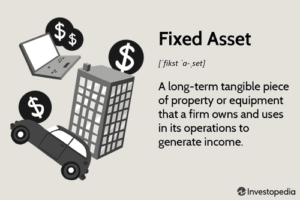Basics of Fixed Assets Accounting
With growth, one tends to acquire new assets. Fixed Assets Accounting helps you in the identification of assets, tracking,
revaluation, non-monetary transfers, depreciation accounting, asset impairment, and eliminating the assets from
financial statements on disposal. We document a process with client approval and the deliverables happen on agreed
timelines.

Types of Fixed Assets
It is a long-term tangible asset that a company uses for production or other business operations. A fixed asset is an item with a value that does not change frequently, such as property, plant, or equipment. This type of asset is not held forresale but is instead used to generate revenue for a business through the provision of goods or services.
There are three main types of fixed assets: property, plant, and equipment. The property includes land and buildings,while the plant refers to machinery, and other equipment used in the production process. Similarly, vehicles are used intransport businesses. Equipment includes office furniture, computers, and other items used in the daily operations of a business.
Fixed assets are important to businesses because they provide the infrastructure necessary to generate revenue. To ensure that these assets are properly maintained, businesses must carefully track and manage them.
Life of a Fixed Asset
In the planning stage, the company decides what asset it needs and how it will be used. The life cycle of a fixed asset starts with procuring the asset, which can be done through leasing, renting, or buying. Once the asset is put into operation, it will start to consume resources and depreciate. The company will need to perform regular repairs and maintenance to keep it in good condition. Finally, when the asset is no longer needed, it will be disposed of in an environmentally responsible manner.

Common Methods of Depreciation
- Straight-line
- Double declining balance
- Units of production
- Sum of years’ digits
- Reducing Balance Method
Say, the straight-line method is often used for assets with a long life span, such as buildings. This is because it results in a lower deduction in the early years and a higher deduction in the later years. Alternatively, the double declining balance method is often used for assets with a short life span, such as computers. As it results in a higher deduction in the early years and a lower deduction in the later years.
Additionally, Modified Accelerated Cost Recovery System (MACRS) is used for tax purposes. MACRS is used for tax purposes and allows businesses to recover the costs of their assets over a shorter period. MACRS is a complex system, but it provides businesses with several benefits. This system is divided into two categories: General Depreciation System (GDS) and the Alternative Depreciation System (ADS).
Methods to calculate depreciation
One should have a good understanding of the different depreciation methods and be able to choose the one that is bestfor your business. For instance, a company may purchase a piece of machinery with a Useful Life of 10 years. This means that the company will depreciate the cost of the machinery over 10 years. Useful Life is the number of years the asset is expected to be used by the company. The method used to calculate depreciation will depend on the type of asset being depreciated and the financial goals of the business.
Why outsource Fixed Assets Accounting ?
We offer a full range of accounting and compliance services for fixed assets. We have a team of experts who can provide support and advice on a range of issues, from compliance with IFRS to GAAP. By availing of our services, you will get to know at the click of a button – the types of assets, number of assets, landed price, depreciation accounted for, present value, number of years of useful life and balance, additions, and deletions duringthe year.
Our services can help you save time and money and ensure that your fixed assets are properly accounted for. You can plan your cash flow for acquiring new assets or replacing the old ones.